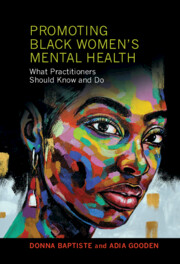Book contents
- Promoting Black Women’s Mental Health
- Promoting Black Women’s Mental Health
- Copyright page
- Contents
- Figures
- Tables
- Contributors
- Introduction
- Part I Black Women in Context
- 1 A Study of Black Women and Psychotherapy
- 2 Social Determinants of Health and Mental Health for Black Women
- 3 Black Girlhood: Developmental Experiences of Black Women
- 4 Stereotypes of Black Women: Clinical Implications
- 5 Black Women and Trauma
- Part II Therapy Contexts
- Part III Core Themes in Black Women’s Stress and Distress
- Part IV Helping Black Women Recover and Thrive
- Appendix
- Index
- References
4 - Stereotypes of Black Women: Clinical Implications
from Part I - Black Women in Context
Published online by Cambridge University Press: 22 June 2023
- Promoting Black Women’s Mental Health
- Promoting Black Women’s Mental Health
- Copyright page
- Contents
- Figures
- Tables
- Contributors
- Introduction
- Part I Black Women in Context
- 1 A Study of Black Women and Psychotherapy
- 2 Social Determinants of Health and Mental Health for Black Women
- 3 Black Girlhood: Developmental Experiences of Black Women
- 4 Stereotypes of Black Women: Clinical Implications
- 5 Black Women and Trauma
- Part II Therapy Contexts
- Part III Core Themes in Black Women’s Stress and Distress
- Part IV Helping Black Women Recover and Thrive
- Appendix
- Index
- References
Summary
In this chapter, we review historical and contemporary stereotypes of Black women in America driven by histories of racism, sexism, and classism. We discuss how these stereotypes impact the mental health of Black women as they navigate these stereotypes, which can cause Black women to feel constrained. We provide recommendations to clinicians for supporting Black women in challenging stereotypes and constructing their own authentic identities. This chapter also discusses ways that clinicians might unconsciously hold common stereotypes about Black women and how unexamined stereotypes can affect the therapeutic alliance. We guide readers to examine their biases toward Black women so that they do not unintentionally affect treatment negatively.
- Type
- Chapter
- Information
- Promoting Black Women's Mental HealthWhat Practitioners Should Know and Do, pp. 88 - 105Publisher: Cambridge University PressPrint publication year: 2023



